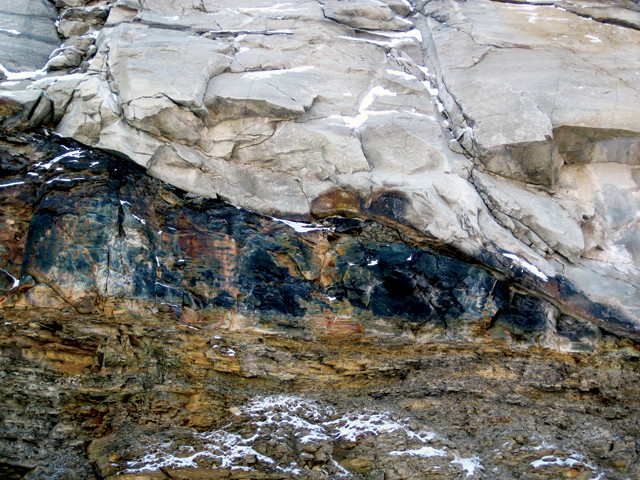
by Lucas Joel Thursday, February 15, 2018

Vast deposits of coal, such as this seam in Kentucky dating to the Middle Pennsylvanian, formed during the Carboniferous Period, and drew down atmospheric carbon dioxide concentrations. Credit: James St. John, CC BY 2.0.
Burning coal releases carbon dioxide, which warms the planet when the gas escapes into the air. On the flip side, coal formation sequesters carbon dioxide removed from the atmosphere by plants, which contributes to global cooling as the planet’s greenhouse gas blanket thins. According to new research, so much carbon was removed from the atmosphere in the Carboniferous Period, when most of Earth’s coal reserves formed, that the planet became almost completely covered in ice.
The Carboniferous, which lasted from about 359 million to 299 million years ago, was a time when vast amounts of plant debris were buried and, eventually, turned into coal. “This reduced the carbon dioxide levels in the atmosphere, leading to cooling and glaciation” toward the end of the period and into the Permian, says Georg Feulner, a climate scientist at the Potsdam Institute for Climate Impact Research in Germany and author of a new study in Proceedings of the National Academy of Sciences. “The new discovery is about how close Earth came to a global glaciation, a state commonly known as Snowball Earth,” he says.
“Snowball Earth” typically refers to severe glacial episodes in the Neoproterozoic before about 650 million years ago when most or all of the planet was likely covered in ice. While the Carboniferous glaciation did not go global, an ice sheet is known to have covered the southern supercontinent Gondwana, and carbon dioxide levels came close to those needed to initiate a global snowball event, Feulner says.
To study the intensity of the late Carboniferous glaciation, Feulner modeled the global climate about 300 million years ago. He accounted for changes in atmospheric carbon dioxide concentrations, as well as other factors like the configuration of the continents (Pangea was by then fully formed); the luminosity of the sun, which was about 3 percent dimmer than it is today, meaning the planet received less heat; and variations in Earth’s orbital parameters, like the shape of the orbit and the tilt of the rotational axis. Of these factors, Feulner found that variations in carbon dioxide levels mattered most in controlling the planet’s thermostat.
“My simulations indicate that global glaciation occurs below 40 parts per million (ppm),” Feulner says, a level that he notes falls within the range of empirical estimates made in a 2016 Nature Geoscience study by paleoclimatologist Isabel Montañez of the University of California, Davis, and colleagues. That study quantified atmospheric carbon dioxide concentrations during the late Paleozoic based on carbonate rock and fossil plant data, finding “that carbon dioxide levels fluctuated strongly during the late Carboniferous, and dropped to 100 plus or minus 80 ppm during the early Permian,” he says.
So how close did the planet get to becoming a snowball once more at the end of the Carboniferous? Unfortunately, the answer is not clear-cut, says Montañez, who was not involved in Feulner’s research. A conservative estimate for the minimum carbon dioxide concentrations in the late Carboniferous is that they were likely between 100 and 200 ppm, she says. “This is our best statistical estimate.” However, carbon dioxide concentrations in Feulner’s model went down well below that window, she explains, to levels that — despite being within the range of uncertainty at the close of the Carboniferous and into the early Permian in her team’s study — may nonetheless be too low.
“We don’t know that it couldn’t have been 80 [ppm],” or lower, Montañez says, but such “low values are not palatable” because of plant survival requirements. With so little carbon dioxide in the air, “how do you feed plants?” she asks. “At 80 ppm, they shouldn’t have thrived.” Even if carbon dioxide concentrations did not sink as low as 80 ppm at the end of the Carboniferous, they were still quite depressed, Montañez says. “Even 100 ppm … that’s really low.”
Regardless of the exact conditions in the Carboniferous, Feulner says, this work “shows how much fossil carbon can influence the climate, both in terms of cooling during coal formation and in terms of warming when that coal is burned.”
© 2008-2021. All rights reserved. Any copying, redistribution or retransmission of any of the contents of this service without the expressed written permission of the American Geosciences Institute is expressly prohibited. Click here for all copyright requests.